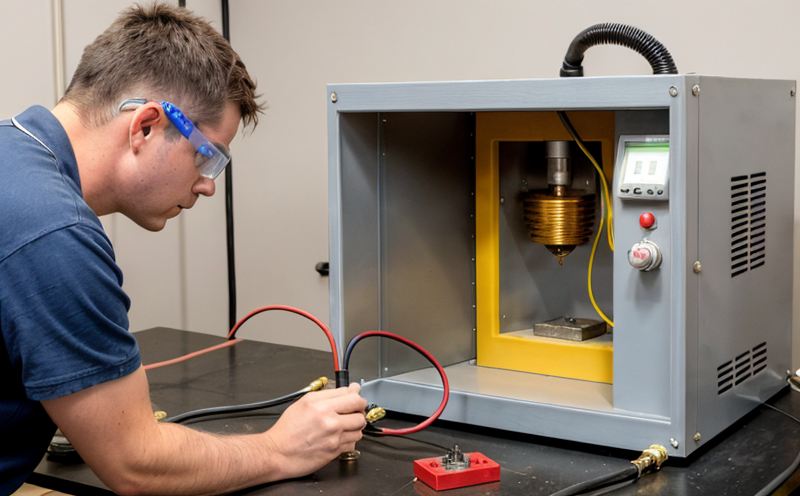ASTM B193 Conductivity of Silver and Precious Metals
The ASTM B193 standard provides a method for determining the electrical conductivity of silver and precious metals, which is critical in quality assurance, compliance, and research within metallurgy. Electrical conductivity plays a pivotal role in selecting suitable materials for various industries, especially those involving conductive materials like electrical wiring, jewelry, and electronic components.
Testing electrical conductivity according to ASTM B193 ensures that the material meets industry standards and specifications, thereby enhancing product reliability and performance. This test is particularly important for precious metals such as silver, gold, platinum, palladium, and iridium. The method involves measuring the resistance of a sample between two electrodes under controlled conditions.
The process begins with carefully selecting the specimen, which should be free from impurities or contaminants that could affect conductivity measurements. After preparation, the sample is placed in a solution designed to minimize surface effects on the measurement results. The test apparatus then applies an alternating current (AC) voltage across the sample and measures the resulting current. From these values, the electrical resistance of the specimen can be calculated.
The accuracy of ASTM B193 relies heavily on precise control over experimental conditions such as temperature, solution composition, and electrode separation distance. These factors ensure consistent results that are comparable to those reported by other laboratories using this standard method. The test apparatus typically consists of precision electronic instruments capable of delivering controlled AC voltage and measuring milliampere-level currents.
The ASTM B193 procedure allows for both direct testing on polished surfaces and indirect evaluation through solutions if necessary. This flexibility accommodates different types of samples and applications, making it a versatile tool in material science research. By adhering to this standard, laboratories can produce reliable data that contributes to the development of high-quality materials.
Understanding the electrical conductivity of silver and precious metals is essential for various sectors including jewelry manufacturing, electronics assembly, aerospace engineering, and medical device production. Accurate measurements help ensure compliance with relevant regulations while improving product design and performance.
| Industry | Specific Application | ASTM B193 Use Case |
|---|---|---|
| Jewelry Manufacturing | Ensuring consistent quality of precious metal alloys used in jewelry. | Determining the purity and conductivity of silver-based alloys to meet regulatory standards. |
| Electronics Assembly | Selecting appropriate connectors and contacts for high-performance circuits. | Evaluating the electrical performance of solder joints made from precious metals like gold or platinum. |
| Aerospace Engineering | Optimizing weight-to-strength ratios in structural components. | Assessing the suitability of titanium alloys for critical parts requiring both strength and conductivity. |
| Medical Device Production | Selecting biocompatible materials for implants or catheters. | Verifying that gold-containing medical devices meet strict electrical performance requirements. |
The ASTM B193 method is widely recognized and used globally, ensuring uniformity in testing practices across different regions. Adhering to this standard helps maintain consistency in material specifications and fosters trust among stakeholders involved in the supply chain for precious metals.
Applied Standards
The primary applied standard for conducting ASTM B193 tests is ASTM B193-20, which specifies the procedure for determining the electrical conductivity of silver and other precious metals. This standard ensures that all laboratories performing these tests follow consistent procedures, leading to reliable and comparable results.
ASTM B193 outlines several key aspects including specimen preparation, test setup, measurement techniques, and data interpretation. It also provides guidelines on reporting the findings in a manner that is clear and understandable for those involved in quality assurance processes.
The standard emphasizes the importance of controlling variables such as temperature, solution composition, and electrode placement to minimize errors and ensure accurate conductivity measurements. By adhering strictly to ASTM B193-20, laboratories can produce reliable data that meets both internal quality control requirements and external regulatory expectations.
Benefits
Conducting ASTM B193 tests brings numerous benefits to organizations working with silver and other precious metals. Firstly, it ensures compliance with industry standards and regulations, which is crucial for maintaining a good reputation and meeting customer expectations. Secondly, accurate conductivity testing helps identify any deviations from expected specifications early in the production process, allowing corrective actions to be taken promptly.
By using ASTM B193 methods, manufacturers can enhance product reliability by ensuring consistent electrical performance across batches of precious metal products. This leads to improved quality control and reduced waste associated with rework or scrap due to non-conforming materials.
The method also supports innovation in material science research by providing reliable data that can be used to develop new alloys or improve existing ones based on their electrical properties. Additionally, it facilitates better communication between suppliers, manufacturers, and end-users through standardized reporting practices.
Moreover, ASTM B193 contributes significantly to sustainability efforts by promoting the efficient use of precious metals in applications where conductivity is critical. This reduces waste generation while maximizing resource utilization efficiency throughout the supply chain.
Industry Applications
- Jewelry manufacturing: Ensuring consistent quality of precious metal alloys used in jewelry.
- Electronics assembly: Selecting appropriate connectors and contacts for high-performance circuits.
- Aerospace engineering: Optimizing weight-to-strength ratios in structural components.
- Medical device production: Selecting biocompatible materials for implants or catheters.
In each of these industries, ASTM B193 plays a vital role by providing reliable data on the electrical conductivity of precious metals. This information is essential for maintaining quality standards and ensuring products meet regulatory requirements.





